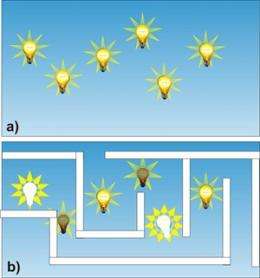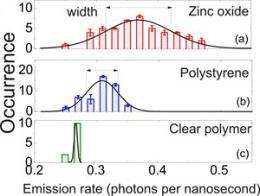Molecular light sources sensitive to environment

A Dutch-French team of scientists led by FOM (Foundation for Fundamental Research on Matter) researcher Dr Danang Birowosuto and University of Twente researcher Dr Allard Mosk has obtained the first experimental evidence that fluorescing molecules behave differently in opaque, light-scattering materials than they do in transparent materials.
Although this effect was predicted on a theoretical basis twenty years ago, it has never before been observed. An understanding of this process is important for the design of nanomaterials for energy-efficient lighting, powerful microscopes and efficient solar cells. These researchers published their findings in the prestigious journal Â鶹ÒùÔºical Review Letters.
At the nanoscale, fluorescing molecules behave as highly-efficient light sources. That is why they are frequently used in energy-efficient lighting, computer screens and imaging techniques in the biomedical sciences. In transparent materials identical molecules emit the same number of light particles (photons) per second.
Maze for photons
In many applications, however, these molecules are not contained in a transparent material. The white, light-scattering phosphorous layer in energy-saving lamps and white LED lamps is an opaque milky colour, for example. This is because the material forms a light-scattering maze, in which photons regularly switch direction. In the 1990s, it was predicted that the molecules of such materials would emit variable amounts of light. Dependent on the way in which the surrounding, light-scattering nanoparticles are arranged, some molecules emit more photons per second than others.
The process by which a molecule emits a photon (spontaneous emission) is influenced by the nano-environment, and it is this effect that gives rise to the variation in light emission. Dependent on its size and position, a light-scattering particle at a distance of several nanometres can either make it easier or more difficult for a molecule to emit a photon.
Nanobeads
These scientists from the MESA+ Institute for Nanotechnology at the University of Twente and from Grenoble University in France were the first to obtain clear experimental evidence that these light sources varied in this way. The experiments were performed using nanobeads filled with fluorescent molecules. These nanobeads were just 25 nanometres in diameter - more than a million times smaller than a human cell. Sensitive measurements were able to detect the beads, even when they were surrounded by a myriad of light-scattering particles.

After mixing the nanobeads with strongly scattering materials made of polystyrene and zinc oxide (a paint pigment), the researchers measured the amount of light emitted per second. In a transparent medium, this quantity was the same for each nanobead. In light-scattering media, however, the amount of light emitted varied considerably. The greater the light-scattering effect of the medium, the greater the variability. On the basis of these measurements, the researchers developed a new model to explain the range of this variability.
This result has increased our understanding of how light is emitted in light-scattering materials. In addition to improving existing light sources, this knowledge can be used in the development of new imaging techniques for studying biochemical processes in cells.
More information: 'Observation of spatial fluctuations of the local density of states in random photonic media' published online by Â鶹ÒùÔºical Review Letters:
Provided by University of Twente

















